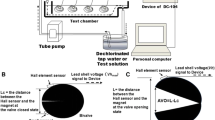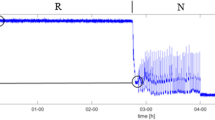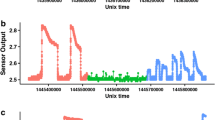Abstract
Biological sensors are becoming more important to monitor the quality of the aquatic environment. In this paper the valve movement response of freshwater (Dreissena polymorpha) and marine (Mytilus edulis) mussels is presented as a tool in monitoring studies. Examples of various methods for data storage and data treatment are presented, elucidating easier operation and lower detection limits. Several applications are mentioned, including an early warning system based on this valve movement response of mussels.
Similar content being viewed by others
References
Abel, P. D., 1976. Effect of some pollutants on the filtration rate of Mytilus. Mar. Poll. Bull. 7: 228–231.
Akberali, H. B. & J. E. Black, 1980. Behavioural responses of the bivalve Scrobicularia plana (da Costa) subjected to short-term copper (Cu II) concentrations. Mar. Environm. Res. 4: 97–107.
Akberali, H. B. & J. Davenport, 1982. The detection of salinity changes by the marine bivalve molluscs Scrobicularia plana (da Costa) and Mytilus edulis (L.). J. Exp. Mar. Biol. Ecol. 58: 59–71.
Akberali, H. B. & E. R. Trueman, 1985. Effects of the environmental stress on marine molluscs. Adv. Mar. Biol. 22: 102–198.
Ameyaw-Akumfi, C. & E. Naylor, 1987. Temporal patterns of shell-gape in Mytilus edulis. Mar. Biol. 95: 237–242.
Barnes, G. E., 1955. The behaviour of Anodonta cygnea L., and its neurophysiological basis. J. Exp. Biol., 32: 158–174.
Bennett, M. F., 1954. The rhythmic activity of the quahog, Venus mercenaria, and its modification by light. Bio. Bull. Mar. Biol. Lab. 107: 174–191.
Bayne, B. L., D. R. Dixon, A. Ivanovici, D. R. Livingstone, D. M. Lowe, M. N. Moore, A. R. D. Stebbing & J. Widdows, 1985. The effects of stress and pollution on marine animals. Preager Scientific, New York, 384 pp.
Cairns, J., 1979. Biological monitoring — concept and scope. In: J. Cairns, G. P. Patil & W. E. Waters (eds.). Environmental biomonitoring, assessment, prediction and management. Int. Co-op Publ. House, Burtonsville, Ma, pp. 3–20.
Davenport, J., 1977. A study of the effect of copper applied continuously and discontinuously to specimens of Mytilus edulis (L) exposed to steady and fluctuating salinity levels. J. Mar. Biol. Ass. UK. 57: 63–74.
Davenport, J., 1979. The isolation response of mussels (Mytilus edulis L.) exposed to falling sea-water concentrations. J. Mar. Biol. Ass. UK. 59: 123–132.
Davenport, J., 1981. The opening response of mussels (Mytilus edulis) exposed to rising sea-water concentrations. J. Mar. Biol. Ass. U.K. 61: 667–678.
De Kock, W. C., 1986. Monitoring bio-available marine contaminants with mussels (Mytilus edulis) in the Netherlands. In: C. J. M. Kramer & G. P. Hekstra (eds). Monitoring in the marine environment. Part II. Environm. Mon. Assessm. 7: 209–220.
De Zwart, D. & W. Slooff, 1987. Continuous effluent biomonitoring with an early warning system. In: Bengston, Norberg-King & Mount (Eds.). Effluent and ambient toxicity testing in the Göta Alv and Viskan Rivers, Sweden. Naturvardsverket Report 3275, 40 pp.
Djangmah, J. S., S. E. Shumway & J. Davenport, 1979. Effects of fluctuating salinity on the behaviour of the west African blood clam Anadara senilus and on the osmotic and ionic concentrations of the haemolymph. Mar. Biol. 50: 209–213.
Geller, W., 1984. A toxicity warning monitor using weakly electric fish, Gnathonemus petrsi. Wat. Res. 18: 1285–1290.
Goldberg, E. D., V. T. Bowen, J. W. Farrington, G. Harvey, J. H. Martin, P. L. Parker, R. W. Risebrough, W. Robertson, E. Schneider & E. Gamble, 1978. The mussel watch. Environm. Conserv. 5: 101–125.
Gruber, D. S. & J. M. Diamond, 1988. Automated biomonitoring — living sensors as environmental monitors. Ellis Horwood, Chichester, 208 pp.
Higgins, P. J., 1980. Effects of food availability on the valve movements and feeding behaviour of juvenile Crassostrea virginica (Gmelin). I. Valve movements and periodic activity. J. Exp. Mar. Biol. Ecol., 45: 229–244.
Hiscock, I. D., 1950. Shell movements of the freshwater mussel Hyridella australis Lam. (Lamellibranchiata). Aus. J. Mar. Freshwat. Res. 1: 260–268.
Jenner, H. A., F. Noppert & T. Sikking, 1989. A new system for the detection of valve movement response of bivalves. KEMA scientific and technical report 1989–7–2. ISSN-0167–8590, KEMA, Arnhem, Netherlands. 7: 91–98.
Juhnke, I. & W. K., 1971. Eine neue Testmethode zur Früherkennung akut toxischer Inhaltstoffen im Wasser. Gewaesser und Abwasser 50/51: 107–114.
Knie, J., 1982. Der Daphnientest. Decheniana, 26: 82–86.
Koeman, J. H., C. L. M. Poels & W. Slooff, 1978. Continuous biomonitoring systems for detection of toxic levels of water pollutants. In: O. Hutzinger, L. H. van Lelyveld & B. C. J. Zoeteman (eds.). Aquatic pollutants: transformation and biological effects. Pergamon, London, pp. 339–347.
Kramer, K. J. M., J. J. Verburgh & E. M. Foekema, 1989. Response of Mytilus edulis to various chemical species of copper. Submitted to Marine Chemistry.
Manley, A. R. & J. Davenport, 1979. Behavioural responses of some marine bivalves to heightened seawater copper concentrations. Bull. Envir. Contam. Toxicol. 22: 739–744.
Manley, A. R., 1983. The effects of copper on the behaviour, respiration, filtration and ventilation activity of Mytilus edulis. J. Mar. Biol. Ass. U.K. 63: 205–222.
Manley, A. R., L. L. D. Gruffydd & P. C. Almada-Villela, 1984. The effect of copper and zinc on the shell growth of Mytilus edulis measured by a laser diffraction technique. J. Mar. Biol. Ass. U.K. 64: 417–427.
Marceau, F., 1909. Recherche sur la morphologie, et l'histologie, et la physiologie comparées des muscles adducteurs des mollusques acephales. Arch. Zool. Exp. Gén. (Ser 5), 2: 295–469.
NAS, 1980. The international mussel watch. National Academy of Sciences, Washington DC, 148 pp.
Noppert, F., 1987. Unio, een systemm voor het automatische regristratie en verwerken van klepbewegingsgedrag van bivalven. KEMA report 00610-MOA-1637 (in Dutch). 37 pp.
Phillips, D. J. H., 1977. The use of biological indicator organisms to monitor trace metal pollution in marine and estuarine environments — a review. Envir. Pollut. 13: 281–317.
Phillips, D. H. J., 1980. Quantitative aquatic biological indicators. Pollution monitoring series. Applied Science Publ. London, 488 pp.
Poels, C. L. M., 1977. An automatic system for rapid detection of acute high concentrations of toxic substances in surface water using trout. In: Cairns, Dickson & Westlake (Eds). Biological monitoring of water and effluent quality. pp. 85–95, ASTM, STP607.
Sabourin, T. D. & R. E. Tullis, 1981. Effect of three aromatic hydrocarbons on respiration and heart rates of the mussel, Mytilus californianus. Bull. Envir. Contam. Toxicol. 26: 729–736.
Salanki, J. & L. Balla, 1964. Ink-Lever equipment for continuous recording of activity in mussels. Annal. Biol. Tihany. 31: 117–121.
Salanki, J. & F. Lukacsovics, 1967. Filtration and O2 consumption related to the periodic activity of freshwater mussel (Anodonta cygnea L.). Annal. Biol. Tihany, 34: 85–98.
Salanki, J. & L. Varanka, 1976. Effect of copper and lead compounds on the activity of the fresh-water mussel. Annal. Biol. Tihany, 43: 21–27.
Salanki, J. & L. Varanka, 1978. Effect of some insecticides on the periodic activity of the fresh-water mussel (Anodonta cygnea L.). Acta. Biol. Acad. Sci. Hung. 29: 173–180.
Schuring, B. J. & M. J. Geense, 1972. Een electronische schakeling voor bet registreren van openingshoek van de mossel Mytilus edulis L. TNO-Rapport CL 72/47 (in Dutch). 8 pp.
Slooff, W., D. de Zwart & J. M. Marquenie, 1983. Detection limits of a biological monitoring system for chemical water pollution based on mussel activity. Bull. Envir. Contam. Toxicol. 30: 400–405.
Stephenson, R. R. & D. Taylor, 1975. The influence of EDTA on the mortality and burrowing activity of the clam (Venerupis decussata) exposed to sub lethal concentrations of copper. Bull. Envir. Contam. Toxicol. 14: 304–308.
Widdows, J., D. K. Phelps & W. Galloway, 1981. Measurement of physiological condition of mussels transplanted along a pollution gradient in Narragansett Bay. Mar. Environm. Res. 4: 181–194.
Widdows, J., 1973. Effect of temperature and food on the heart beat, ventilation rate and oxygen uptake of Mytilus edulis. Mar. Biol. 20: 269–276.
Widdows, J., 1985. Physiological responses to pollution. Mar. Pollut. Bull. 16: 129–134.
Author information
Authors and Affiliations
Rights and permissions
About this article
Cite this article
Kramer, K.J.M., Jenner, H.A. & de Zwart, D. The valve movement response of mussels: a tool in biological monitoring. Hydrobiologia 188, 433–443 (1989). https://doi.org/10.1007/BF00027811
Issue Date:
DOI: https://doi.org/10.1007/BF00027811




